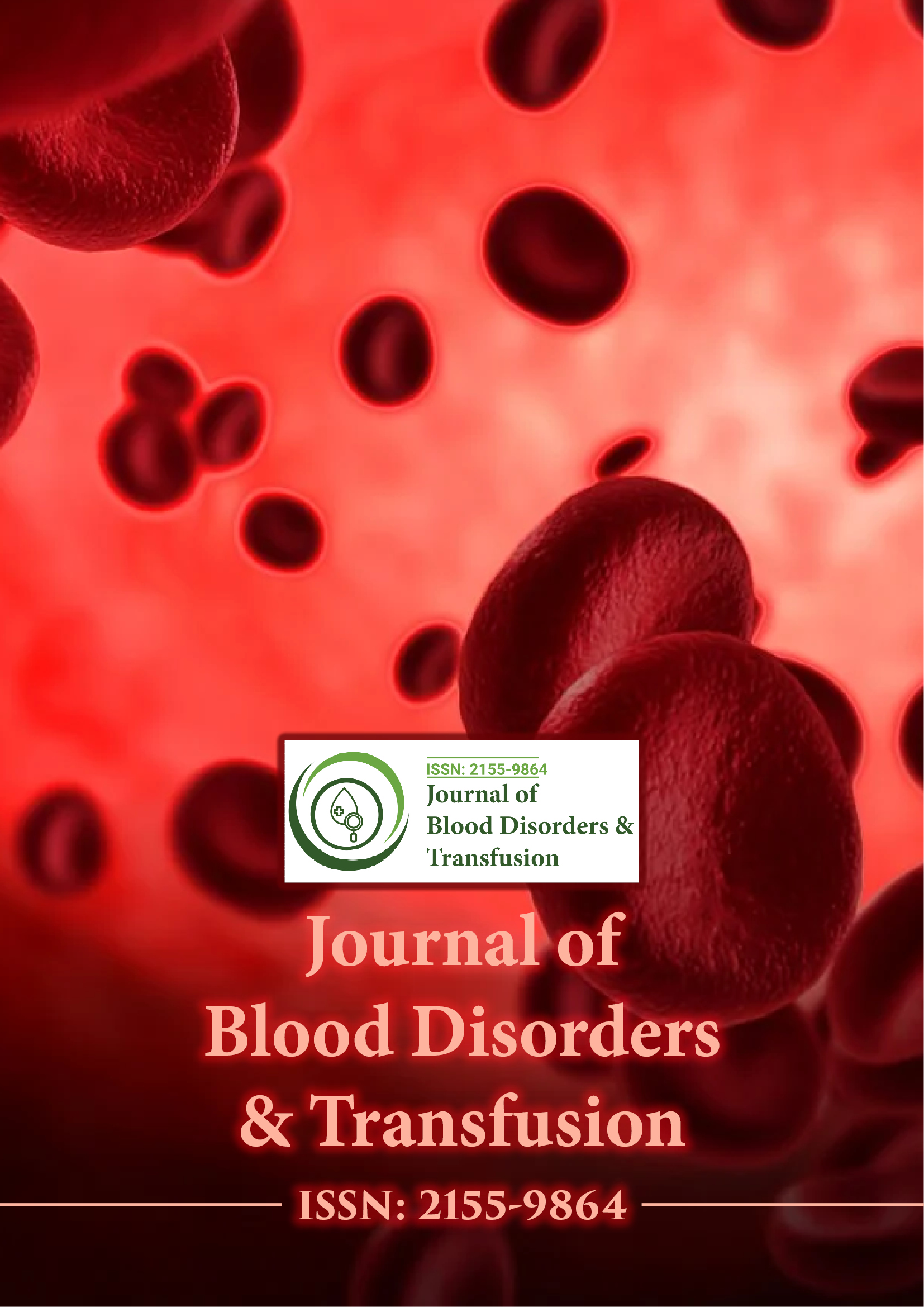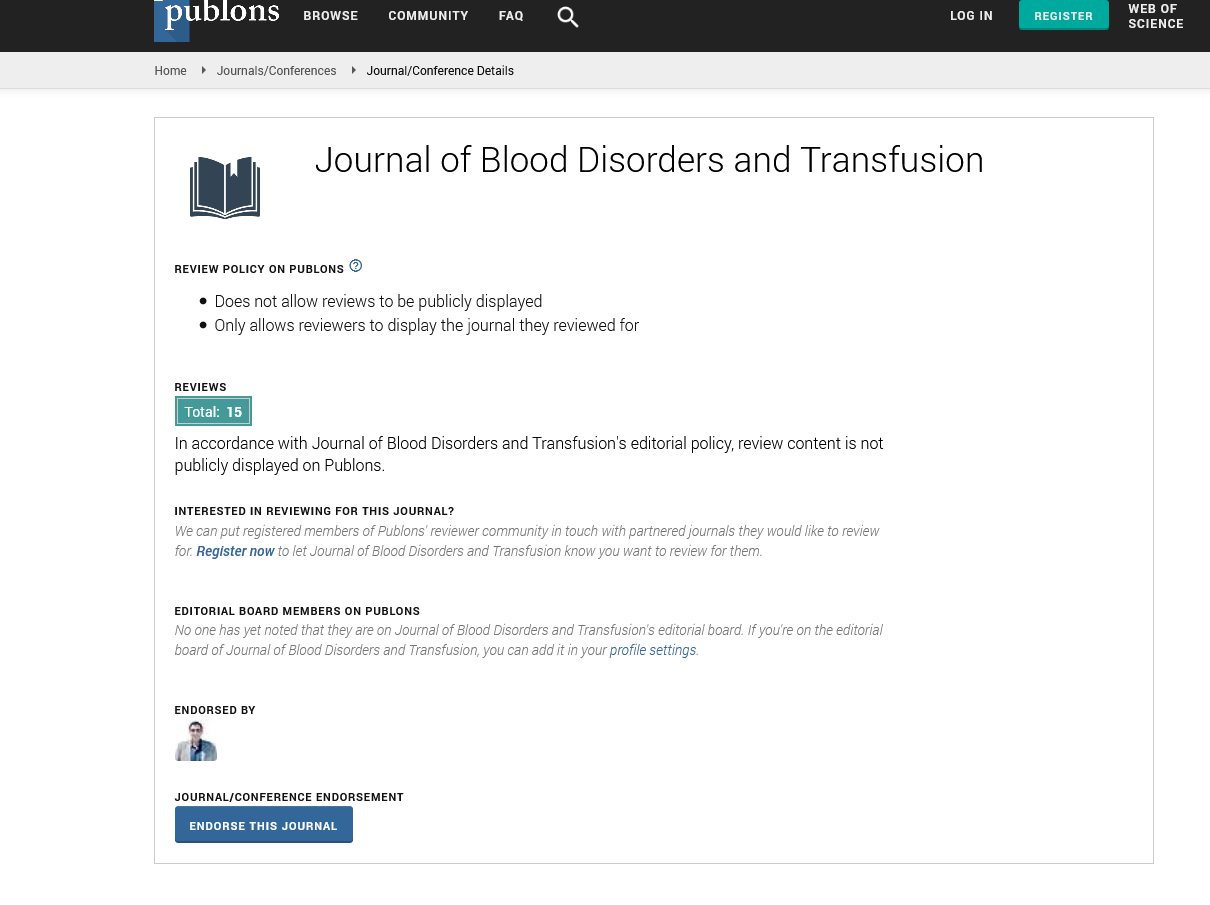Indexed In
- Open J Gate
- Genamics JournalSeek
- JournalTOCs
- Ulrich's Periodicals Directory
- RefSeek
- Hamdard University
- EBSCO A-Z
- OCLC- WorldCat
- Proquest Summons
- Publons
- Geneva Foundation for Medical Education and Research
- Euro Pub
- Google Scholar
Useful Links
Share This Page
Journal Flyer

Open Access Journals
- Agri and Aquaculture
- Biochemistry
- Bioinformatics & Systems Biology
- Business & Management
- Chemistry
- Clinical Sciences
- Engineering
- Food & Nutrition
- General Science
- Genetics & Molecular Biology
- Immunology & Microbiology
- Medical Sciences
- Neuroscience & Psychology
- Nursing & Health Care
- Pharmaceutical Sciences
Short Communication - (2025) Volume 0, Issue 0
The Role of Platelets in Blood Clot Formation and Treatment
Huimin Wu*Received: 28-Mar-2025, Manuscript No. JBDT-25-28995; Editor assigned: 01-Apr-2025, Pre QC No. JBDT-25-28995 (PQ); Reviewed: 15-Apr-2025, QC No. JBDT-25-28995; Revised: 22-Apr-2025, Manuscript No. JBDT-25-28995 (R); Published: 29-Apr-2025, DOI: 10.4172/2155-9864.25.S13.065
Description
Venous Thromboembolism (VTE), encompassing Deep Vein Thrombosis (DVT) and Pulmonary Embolism (PE), remains a significant health concern worldwide. VTE results from the formation of clots in the venous system, causing morbidity and mortality. While the involvement of coagulation factors in VTE has been well studied, the role of platelets has gained increasing attention over recent years. Platelets contribute not only to arterial thrombosis but also to venous thrombus formation, influencing both the initiation and propagation of clots.
Microparticles and platelet activity
Platelets release microparticles upon activation, which carry phosphatidylserine on their surface. These microparticles provide catalytic surfaces for coagulation enzyme complexes, enhancing thrombin production. Elevated levels of platelet-derived microparticles have been observed in patients with VTE, further supporting their role [1-3].
Risk factors
Risk factors for VTE include immobilization, surgery, cancer, pregnancy, hormonal therapy, inherited thrombophilias, obesity and advanced age. Platelet hyperreactivity and elevated platelet counts have been associated with increased VTE risk, suggesting platelet status may influence susceptibility.
Diagnostic methods
Diagnosis integrates clinical evaluation with imaging and laboratory tests. Compression ultrasonography is the primary modality for suspected DVT, while Computed Tomography Pulmonary Angiography (CTPA) confirms PE. D-dimer testing helps exclude VTE in low-risk patients but lacks specificity [4-7].
Platelet function and VTE recurrence
Patients with a history of VTE are at risk of recurrence. Studies reveal that enhanced platelet reactivity, increased microparticle levels and elevated platelet-leukocyte aggregates are associated with higher recurrence rates. These findings support ongoing evaluation of platelet activity as a prognostic factor.
Current therapeutic approaches
Anticoagulation remains the mainstay of VTE treatment, focusing on preventing clot extension and new thrombus formation. Heparins, vitamin K antagonists and Direct Oral Anticoagulants (DOACs) inhibit various coagulation enzymes but have limited direct effects on platelet function.
Platelet biomarkers
The identification of platelet activation markers offers opportunities to stratify patients by risk and optimize therapy. Biomarkers like soluble P-selectin, platelet microparticles and platelet-derived microRNAs are under investigation as tools for predicting VTE risk, treatment response and recurrence. Personalized medicine approaches may incorporate platelet function testing to guide anticoagulant or antiplatelet choice and dosing, minimizing adverse events while maximizing efficacy [8-10].
Conclusion
Platelets contribute significantly to the pathogenesis and progression of venous thromboembolism. Their interaction with coagulation factors, immune cells and the endothelium shapes thrombus formation and stability. While anticoagulants remain the cornerstone of treatment, emerging therapies targeting platelet activation pathways offer additional options.
References
- Bekeschus S, Poschkamp B, van der Linde J. Medical gas plasma promotes blood coagulation via platelet activation. Biomaterials. 2021;278:120433.
- Wada H, Shiraki K, Matsumoto T, Ohishi K, Shimpo H, Shimaoka M. Effects of platelet and phospholipids on clot formation activated by a small amount of tissue factor. Thromb Res. 2020;193:146-153.
- Fong KP, Molnar KS, Agard N, Litvinov RI, Kim OV, Wells JA, et al. Cleavage of talin by calpain promotes platelet-mediated fibrin clot contraction. Blood Adv. 2021;5(23):4901-4909.
- Aburima A, Berger M, Spurgeon BE, Webb BA, Wraith KS, Febbraio M, et al. Thrombospondin-1 promotes hemostasis through modulation of cAMP signaling in blood platelets. Blood. 2021;137(5):678-689.
- Khan AA, Hardy LJ, Shantsila E, Lau YC, Philippou H, Lip GY. Observations on clot properties in atrial fibrillation: Relation to renal function and choice of anticoagulant. Thromb Res. 2021;197:69-76.
- Jian F, Lu C, Jia H, Na L, Peng Y, Maohong B, et al. Characteristics of blood clotting on thromboelastography in patients with early burns. Transfus Apher Sci. 2023;62(6):103824.
- Evtugina NG, Peshkova AD, Khabirova AI, Andrianova IA, Abdullayeva S, Ayombil F, et al. Activation of Piezo1 channels in compressed red blood cells augments platelet-driven contraction of blood clots. J Thromb Haemost. 2023;21(9):2418-2429.
- Gauer JS, Ajanel A, Kaselampao LM, Candir I, MacCannell AD, Roberts LD, et al. Plant-derived compounds normalize platelet bioenergetics and function in hyperglycemia. Res Pract Thromb Haemost. 2024;8(6):102548.
- Tarandovskiy ID, Ovanesov MV. The effect of factor XIa on thrombin and plasmin generation, clot formation, lysis and density in coagulation factors deficiencies. Thromb Res. 2024;233:189-199.
- Urano T, Sano Y, Suzuki Y, Okada M, Sano H, Honkura N, et al. Evaluation of thrombomodulin/thrombin activatable fibrinolysis inhibitor function in plasma using tissue-type plasminogen activator-induced plasma clot lysis time. Res Pract Thromb Haemost. 2024;8(4):102463.
Citation: Wu H (2025). The Role of Platelets in Blood Clot Formation and Treatment. J Blood Disord Transfus. S13:065.
Copyright: © 2025 Wu H. This is an open-access article distributed under the terms of the Creative Commons Attribution License, which permits unrestricted use, distribution, and reproduction in any medium, provided the original author and source are credited.

